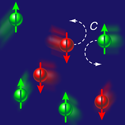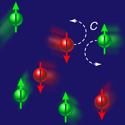One relation to rule them all
Quantum gases of ultracold fermions offer a versatile way to study phenomena from quark matter to superconductors. In 2008, Shina Tan (then at the University of Washington) published a set of exact universal relations connecting microscopic quantities with thermodynamic variables under a wide range of conditions. Recently, a group at JILA experimentally verified some of the Tan relations in ultracold potassium- [1]. Writing in Physical Review Letters, Eva Kuhnle and colleagues at Swinburne University of Technology in Melbourne, Australia, now add to the picture with their results on lithium- .
Kuhnle et al. used Bragg scattering of atoms from a periodic optical potential to verify one of the Tan relations for pair correlations as a function of both the scattering length and probe momentum. This complements the JILA work, which verified a relation between total energy and adiabatic changes in scattering length, and another relation that extends the virial theorem (which expresses total energy in terms of kinetic energy, external potential energy, and interaction energy) to quantum gases. – David Voss
[1] J. T. Stewart, J. P. Gaebler, T. E. Drake, and D. S. Jin, Phys. Rev. Lett. 104, 235301 (2010); see also Viewpoint commentary by D. Sheehy, Physics 3, 48 (2010).





